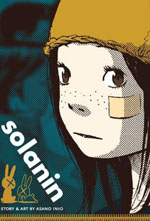 By Inio Asano
By Inio Asano
432 pages, black and white
Published by Viz
Sometimes, it’s just the cover image that sells you on a book. With a comic like Solanin, it’s easy to see how that would happen. With the lead character’s face staring out at the reader, band-aid under one eye, cap on head, it’s hard to not feel your heart soften a bit at even a glance. And from there, it’s not far to looking at the insides and discovering that it looks even more enchanting, with its group of recent college graduates and their interactions. But the reality is that despite all the cuteness, this is a book that’s a lot tougher than you might initially think—and it’s that toughness that makes Solanin that much more memorable.
Meiko Inoue didn’t think this is what her life would end up as. Her job in an office pays really well, but it’s mind-numbingly boring. Her boyfriend Taneda has moved in with her, but it has more to do with not being able to afford his own rent than some huge romantic gesture. Her parents send her boxes of vegetables that are going to rot before she can possibly eat them all. Taneda and her friends are in a band, but they don’t seem to actually be going anywhere. Is this really what Meiko wants for the rest of her life? Or can she jumpstart herself and really make a change?
Originally running two volumes in Japan (but printed in English as an omnibus), it’s easy to draw a line right down the middle of Solanin and view it as two different, distinct books in their own right. The first half of Solanin is in many ways about getting to know the cast, understanding not only Meiko and Taneda but all of their friends that exist in various orbits around them. Honestly, had we just had one volume of Solanin consisting of these little vignettes and anecdotes about the cast, I’d have been happy. Inio Asano brings a real charm to these characters, and from a trip to the zoo, to dealing with an aged customer who always forgets that a statue isn’t really a mailbox, they’re all enjoyable. Meiko and Taneda are certainly the most fully fleshed out, but you still get a strong sense of whom everyone else is and what they’re all about.
As for the second half of Solanin, without giving anything away, it’s certainly different. The characters have to deal with a big change in their group, and while there’s still fun and amusement, there’s also a lot more sadness and regret. At the same time, though, I think it’s safe to say that Solanin becomes a much better book for it. It not only ends up making Solanin a more realistic depiction of life for young adults, but it certainly adds a lot more of a central conflict and allows for growth in many of the characters, especially Meiko. Some of the decisions felt a tiny bit out of the blue to me at first, but the more I read it, the more that Asano really sold it to me. If you’ve become attached to the characters it’s hard to not feel sad for them in places, and that’s the sign of a well-written book.
Asano’s art is, quite frankly, gorgeous. If I didn’t know better at first, I’d have thought that some of the panels were black and white animation stills, printed onto paper—except to be honest, doing that never looks as crisp and attractive as Asano’s finished art. And if I’d mentioned how Asano brings cuteness to the book through the writing, it’s doubly so with the art. I didn’t think it would be possible to make a two-room cramped apartment look both realistic and appealing to me (I own too many books to fit them all in to such a place), but Asano manages quite nicely. And in many ways, that’s how Asano handles the entire book. Very realistic, but at the same time there’s a certain level of charm and appeal that is through Asano’s presentation; people squishing their faces on a subway car glass shouldn’t look that amusing, or watching elderly people trying to mail a letter through a statue. And when the sad moments of Solanin happen, well, just hold onto your proverbial hat. Looking at the crushed expressions of many of the characters will make you feel just as bad as them.
I really hope that we’re getting some more of Asano’s comics translated into English, because Solanin was remarkably good. I almost feel bad that it’s one of the first books I’ve read this year, because it means that everything afterwards is going to have a lot to live up to. It’s easy to see why this is part of Viz’s Signature line; this is a classy, beautiful book and at over 400 pages, a bargain to boot. Highly recommended.
Purchase Links: Amazon.com
